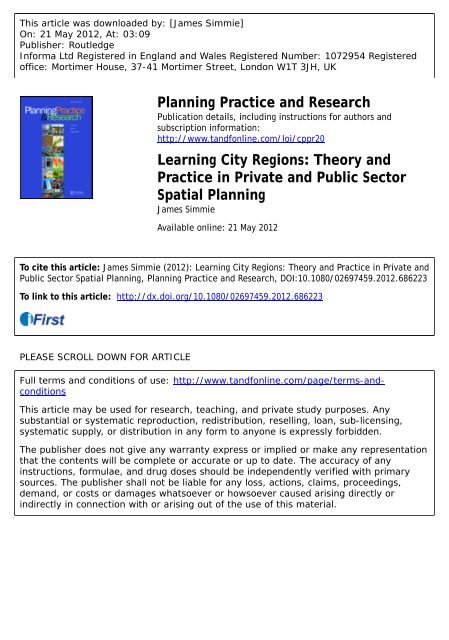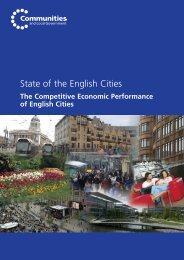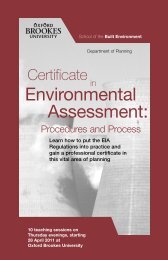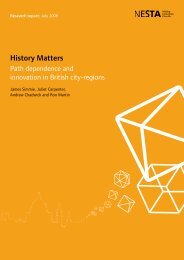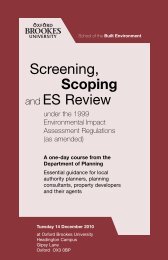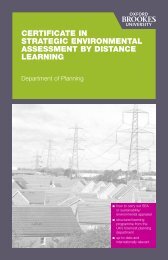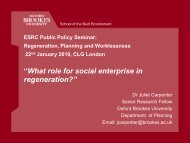Theory and Practice in Private and Public Sector Spatial Planning
Theory and Practice in Private and Public Sector Spatial Planning
Theory and Practice in Private and Public Sector Spatial Planning
- No tags were found...
Create successful ePaper yourself
Turn your PDF publications into a flip-book with our unique Google optimized e-Paper software.
James SimmieDownloaded by [James Simmie] at 03:09 21 May 2012that, if anyth<strong>in</strong>g, these gaps were ‘diverg<strong>in</strong>g’ rather than ‘converg<strong>in</strong>g’ (Chatterji &Dewhurst, 1996; Dunford, 1997; Mart<strong>in</strong> & Sunley, 1998; Rowthorn, 1999;Roberts, 2004; Henley, 2005; Simmie & Carpenter, 2008). In the face of suchevidence, new polices were clearly required. These sought to address the issue ofhow to accelerate the generation of knowledge <strong>and</strong> <strong>in</strong>novation <strong>in</strong> LFRs. It wasargued <strong>in</strong> this context that what they needed was a set of <strong>in</strong>stitutions that couldgalvanize local learn<strong>in</strong>g, knowledge <strong>and</strong> <strong>in</strong>novation.Start<strong>in</strong>g from this policy perspective, a second policy def<strong>in</strong>ition of the learn<strong>in</strong>gregion has emerged. This is that ‘A learn<strong>in</strong>g region can be def<strong>in</strong>ed as a regional (orurban) <strong>in</strong>novation strategy <strong>in</strong> which a broad set of <strong>in</strong>novation-related actors(politicians, policy-makers, chambers of commerce, trade unions, higher education<strong>in</strong>stitutes, public research establishments <strong>and</strong> companies) are strongly but flexiblyconnected with each other <strong>and</strong> who stick to a certa<strong>in</strong> set of ‘policy pr<strong>in</strong>ciples’’(Hass<strong>in</strong>k, 2001 quot<strong>in</strong>g OECD, 2001, p. 24). Here, the focus is on regional <strong>and</strong>urban <strong>in</strong>novation strategies.Thus, there are two dist<strong>in</strong>ct def<strong>in</strong>itions of the learn<strong>in</strong>g region. The first is atheoretical def<strong>in</strong>ition that focuses on the processes of regional learn<strong>in</strong>g <strong>and</strong> howthey may lead to regional economic renewal. The second is a policy-baseddef<strong>in</strong>ition <strong>and</strong> focuses on strategies needed to generate <strong>in</strong>novation <strong>and</strong> itsunderly<strong>in</strong>g learn<strong>in</strong>g requirements as new practical bases for the redevelopment ofregional economies. The first offers an alternative underst<strong>and</strong><strong>in</strong>g to that of neoclassical,free market economics on what drives regional economies. The secondsuggests policy pr<strong>in</strong>ciples that follow from this alternative theory for thedevelopment <strong>and</strong> renewal of regional economies based on the encouragement ofendogenous <strong>in</strong>novation <strong>and</strong> learn<strong>in</strong>g.Critics of the <strong>Theory</strong> <strong>and</strong> Policy of the Learn<strong>in</strong>g RegionThe learn<strong>in</strong>g region both as a concept <strong>and</strong> as a policy prescription has attractedconsiderable criticism. Critics <strong>in</strong>clude Hudson (1999), Simmie (1999, 2003),Hass<strong>in</strong>k (2001) <strong>and</strong> Cooke (2005). Hudson (1999) argues that the social <strong>and</strong>structural constra<strong>in</strong>ts imposed by the capitalist system of production set the limitsof what is possible <strong>in</strong> such a system. One important feature of this system isspatially uneven economic development. This is partly based on carefully guardedeconomically valuable tacit knowledge. Hudson (1999) sees the development <strong>and</strong>the use of new knowledge <strong>in</strong> a capitalist system as a zero sum game <strong>in</strong> which onefirm or locality’s ga<strong>in</strong> is another’s loss. He argues that the prospect of generat<strong>in</strong>gconvergence between different regions (or cities) on the basis of a policy focus onlearn<strong>in</strong>g is unlikely to succeed <strong>in</strong> the face of the forces driv<strong>in</strong>g uneven economicdevelopment.Hass<strong>in</strong>k (2001) argues that, from a conceptual perspective, the learn<strong>in</strong>g regionsuffers from def<strong>in</strong>itional fuzz<strong>in</strong>ess, its normative character, the fact that it overlapswith other TIM concepts <strong>and</strong> its uncerta<strong>in</strong> position between national <strong>in</strong>novationsystems <strong>and</strong> global production networks.Cooke (2005) argues that the learn<strong>in</strong>g region is unlikely to last as a policyframework because of asymmetries rather than equality <strong>in</strong> local collaborationsus<strong>in</strong>g different forms of economically valuable knowledge. He dist<strong>in</strong>guishes6
James SimmieDownloaded by [James Simmie] at 03:09 21 May 2012<strong>in</strong>stitutions <strong>in</strong>teract with other actors <strong>in</strong> the region. Such multiple <strong>in</strong>stitutions <strong>and</strong><strong>in</strong>teractions between them have been described as ‘<strong>in</strong>stitutional thickness’ byAm<strong>in</strong> <strong>and</strong> Thrift (1995)This theoretical <strong>and</strong> policy focus on purely local knowledge networks <strong>and</strong><strong>in</strong>stitutions as key features of learn<strong>in</strong>g regions/cities tends to ignore the possibilitythat they can lead to the negative ‘lock-<strong>in</strong>’ of outdated practices <strong>and</strong> <strong>in</strong>dustrialdecl<strong>in</strong>e. They also do not account for the importance of external knowledgenetworks to local learn<strong>in</strong>g.With respect to the first problem, Grabher (1993), for the heavy <strong>in</strong>dustries of theRuhr Area, <strong>and</strong> Maillat (1996), <strong>in</strong> the case of the Swiss mechanical watch <strong>in</strong>dustry,have shown that thick <strong>in</strong>stitutional tissues can also develop <strong>in</strong>to political <strong>and</strong>economic lock-<strong>in</strong>s. In both cases, they aimed at preserv<strong>in</strong>g exist<strong>in</strong>g <strong>in</strong>dustrialstructures <strong>and</strong> had the effect of slow<strong>in</strong>g down <strong>in</strong>dustrial restructur<strong>in</strong>g <strong>and</strong><strong>in</strong>directly hamper<strong>in</strong>g the development of <strong>in</strong>digenous potential <strong>and</strong> the creation ofnew pathways of economic development.With respect to the second problem, Simmie (1999) found <strong>in</strong> a study of<strong>in</strong>novative firms <strong>in</strong> the South East of Engl<strong>and</strong> that they learned as much fromnational <strong>and</strong> <strong>in</strong>ternational networks as they did from their local regional networks.He argued (Simmie, 2003) that, far from regions rely<strong>in</strong>g ma<strong>in</strong>ly on the transfer ofknowledge <strong>and</strong> learn<strong>in</strong>g with<strong>in</strong> locally conf<strong>in</strong>ed networks, the more <strong>in</strong>novativeamong them formed nodes <strong>in</strong> global systems of learn<strong>in</strong>g, knowledge generation<strong>and</strong> <strong>in</strong>novation. In this respect what dist<strong>in</strong>guished successful regions from LFRswas often not only their local networks but also the level <strong>and</strong> quality of their<strong>in</strong>ternational l<strong>in</strong>kages as well.<strong>Spatial</strong> Plann<strong>in</strong>g <strong>and</strong> the Learn<strong>in</strong>g City-RegionCase Study SelectionIn this article, the role of spatial plann<strong>in</strong>g <strong>in</strong> the creation <strong>and</strong> ma<strong>in</strong>tenance oflearn<strong>in</strong>g city-regions is analysed from the perspective of the significance of bothlocal <strong>and</strong> <strong>in</strong>ternational networks as the key to the development of cont<strong>in</strong>uallearn<strong>in</strong>g, adaptation, <strong>and</strong> local economic change <strong>and</strong> growth. It is argued that thenature, geographic characteristics <strong>and</strong> substance of knowledge networks are akey basis of both the theoretical concept <strong>and</strong> policy prescriptions. It is alsoargued that both the theoretical underst<strong>and</strong><strong>in</strong>g <strong>and</strong> policy prescriptions will, <strong>in</strong>pr<strong>in</strong>ciple, be different <strong>in</strong> lead<strong>in</strong>g as opposed to LFRs. For this reason, some ofthe key differences between such contrast<strong>in</strong>g city-regions are illustrated bycompar<strong>in</strong>g <strong>and</strong> contrast<strong>in</strong>g two case studies of a lead<strong>in</strong>g <strong>and</strong> a lagg<strong>in</strong>gcity-region.The two case studies are drawn from a sample frame of all British city-regions(Travel to Work Areas; TTWAs) with populations of more than 125, 000 (Simmieet al., 2008). The empirical justification for the selection is based on theassumption that <strong>in</strong>novations are a significant output from the development <strong>and</strong>commercialization of valuable new economic knowledge <strong>and</strong> are therefore astrong <strong>in</strong>dicator of the historical development of learn<strong>in</strong>g as opposed to nonlearn<strong>in</strong>geconomies, lead<strong>in</strong>g as opposed to LFRs.8
Learn<strong>in</strong>g city regionsThe data on <strong>in</strong>novation outputs were drawn from the geographically codedresults of the Fourth Community Innovation Survey (CIS 4). This covered theperiod from 2002 to 2004. Relatively non-learn<strong>in</strong>g <strong>and</strong> LFRs are identified asthose with the lowest rates of <strong>in</strong>novation, <strong>and</strong> relatively learn<strong>in</strong>g <strong>and</strong> lead<strong>in</strong>g cityregionsare identified as those with the highest rates of <strong>in</strong>novation dur<strong>in</strong>g thisperiod. Table 1 shows that the city-region of Cambridge appears three times <strong>in</strong> thetop decile of cities while Swansea appears four times <strong>in</strong> the bottom decile. The twocities are selected for analysis <strong>in</strong> this article because of these contrast<strong>in</strong>g results.Downloaded by [James Simmie] at 03:09 21 May 2012Historical Development of Learn<strong>in</strong>g <strong>in</strong> Cambridge <strong>and</strong> SwanseaThe analysis turns first to the different historical development trajectories oflearn<strong>in</strong>g <strong>in</strong> the Cambridge <strong>and</strong> Swansea city-regions. Table 2 shows that the keylearn<strong>in</strong>g difference between the two cities has been that the successivedevelopment pathways <strong>in</strong> Swansea have needed the learn<strong>in</strong>g of new forms ofknowledge. There have been few opportunities to transfer tacit knowledge <strong>and</strong>learn<strong>in</strong>g as the local m<strong>in</strong><strong>in</strong>g pathway decayed <strong>and</strong> was eventually closed downaltogether to be replaced by the creation of a new pathway <strong>in</strong> consumer electronicsthat has, itself, also decayed <strong>and</strong> closed to be followed by a more eclectic set ofhigh-technology SMEs.In Table 2, it is also suggested that sequential waves of development <strong>in</strong> Swanseahave required discont<strong>in</strong>uous sets of relevant knowledge that prevented cumulativeknowledge transfer <strong>and</strong> learn<strong>in</strong>g tak<strong>in</strong>g place over time. Thus, firms <strong>in</strong> Swanseawere required to be more radical <strong>in</strong> the learn<strong>in</strong>g of entirely new forms ofknowledge than the path-dependent development of the economy would allow.This contrasts with the history of path development <strong>in</strong> Cambridge. Thesesuccessive knowledge <strong>in</strong>tensive new pathways of development have been created<strong>in</strong> electronic equipment <strong>and</strong> <strong>in</strong>struments, biotechnology, application software <strong>and</strong>latterly clean technologies. Each of these new pathways has been created beforethe preced<strong>in</strong>g one has reached its decay phase. They have also been built on acumulative knowledge base of advanced mathematics <strong>and</strong> comput<strong>in</strong>g for whichthe university is world renowned.The problems confront<strong>in</strong>g LFRs like Swansea <strong>in</strong> break<strong>in</strong>g out of their long-termpath-dependent development trajectories us<strong>in</strong>g policy tools, such as the learn<strong>in</strong>gTABLE 1. Cambridge versus Swansea as learn<strong>in</strong>g <strong>and</strong> non-learn<strong>in</strong>g city-regionMeasure of <strong>in</strong>novation % Top decile Bottom decileFirms <strong>in</strong>troduc<strong>in</strong>g novel products Cambridge 35% Swansea 6%Firms <strong>in</strong>troduc<strong>in</strong>g novel processes Cambridge 10% n.a.Firms <strong>in</strong>troduc<strong>in</strong>g new or improved products Cambridge 45% Swansea 18%Firms <strong>in</strong>troduc<strong>in</strong>g new or improved processes n.a. Swansea 16%Firms implement<strong>in</strong>g changes <strong>in</strong> market<strong>in</strong>g conceptsor strategiesn.a. Swansea 16%Source: CIS4 dataset at city level, for GB cities with a population above 125, 000 <strong>and</strong> a sample sizeof at least 75 firms <strong>in</strong> CIS4.9
James SimmieTABLE 2. Development pathways <strong>in</strong> Swansea <strong>and</strong> CambridgeDownloaded by [James Simmie] at 03:09 21 May 2012Source: Author’s ownregion are illustrated <strong>in</strong> Table 2. It is argued that their characteristic legacy of old<strong>in</strong>dustrial structures, restrictive bus<strong>in</strong>ess cultures <strong>and</strong> a limited skill base restrictsthe scope to create new economic pathways. This leads to a lack of economicmomentum for change <strong>and</strong> a consequential <strong>in</strong>ability to attract a highly skilledworkforce capable of lead<strong>in</strong>g the development of knowledge-based learn<strong>in</strong>geconomy. In turn, this limits <strong>in</strong>digenous <strong>in</strong>novative capabilities <strong>and</strong> the capacity tonetwork with <strong>and</strong> learn from external sources of knowledge. Feedback loops fromthese limitations further re<strong>in</strong>force both the limited potential for the creation of neweconomic pathways <strong>and</strong> restrict the scope <strong>and</strong> scale of local economic growth.<strong>Spatial</strong> Plann<strong>in</strong>g <strong>and</strong> NetworksThe roles of private <strong>and</strong> public spatial plann<strong>in</strong>g <strong>in</strong> the development of both hard<strong>and</strong> soft networks as the basis of connectivity <strong>and</strong> learn<strong>in</strong>g economies <strong>in</strong>Cambridge <strong>and</strong> Swansea are illustrated by two reports on the respective cities. Thefirst provides an analysis of Cambridge as an ‘ideopolis’ (The Work Foundation(WF), 2006). The second is the proposals conta<strong>in</strong>ed <strong>in</strong> the update of the Welsh<strong>Spatial</strong> Plan (Welsh Assembly Government (WAG), 2008) for Swansea Bay—Waterfront <strong>and</strong> Western Valleys. Both plans <strong>in</strong>clude the important assumption thatwhat is required is ‘leadership around a knowledge-city vision’ <strong>in</strong> Cambridge(WF, 2006, p.14) <strong>and</strong> ‘develop<strong>in</strong>g a cutt<strong>in</strong>g edge knowledge economy’ <strong>in</strong> Swansea(WAG, 2008, p. 140). In both cases, the respective plann<strong>in</strong>g policyrecommendations recognize the importance of learn<strong>in</strong>g <strong>and</strong> networks.10
Learn<strong>in</strong>g city regionsDownloaded by [James Simmie] at 03:09 21 May 2012There have been, however, major differences <strong>in</strong> the ways <strong>in</strong> which learn<strong>in</strong>gnetworks have been developed <strong>in</strong> the two city-regions. In the case of Cambridge,much of the success <strong>in</strong> creat<strong>in</strong>g a learn<strong>in</strong>g economy has been led by the privatesector. The private sector, for example, has <strong>in</strong>itiated <strong>and</strong> led the ‘CambridgeNetwork’. Local entrepreneurs started the network as a private bus<strong>in</strong>essnetwork<strong>in</strong>gorganization. It is funded by their subscriptions rather than publicfund<strong>in</strong>g. This k<strong>in</strong>d of privately funded network<strong>in</strong>g differentiates cities likeCambridge from those where networks have only been established as a result ofpublic fund<strong>in</strong>g (WF, 2006, p.10).In Cambridge, a dist<strong>in</strong>ctive style of network<strong>in</strong>g has developed. It <strong>in</strong>volves acomb<strong>in</strong>ation of private sector leadership, network<strong>in</strong>g <strong>and</strong> consultancy that is ableto take advantage of the research base provided by the University (WF, 2006, p.3). The economic success of the city-region has been led by networks ofentrepreneurs, consultants <strong>and</strong> scientists work<strong>in</strong>g <strong>in</strong> collaboration to create the socalled‘Cambridge Phenomenon’ (Segal Qu<strong>in</strong>ce Wicksteed, 1985, 2000). Thesenetworks have been built organically <strong>and</strong>, so far, have been proved adaptable tochange (WF, 2006, p. 14).In contrast to Cambridge, such knowledge networks as have developed <strong>in</strong>Swansea have mostly been <strong>in</strong>stigated by the public sector. They have also<strong>in</strong>volved a higher proportion of public sector actors than <strong>in</strong> Cambridge. Oneexample of this is the South West Wales Knowledge Economy Steer<strong>in</strong>g Group.Although this is a private sector led partnership, its ma<strong>in</strong> actors are the local higher<strong>and</strong> further education <strong>in</strong>stitutions, local authorities <strong>and</strong> the WAG (2008, p. 148).This reflects the fact that many of the high-technology actors <strong>in</strong> the city-region arelocated <strong>in</strong> the public sector. They <strong>in</strong>clude the Blue-C life science supercomputer,the Institute of Advanced Telecommunications at Swansea University <strong>and</strong>expertise <strong>in</strong> digital media at Swansea Metropolitan University. <strong>Private</strong> sectoractors <strong>in</strong>clude BT <strong>and</strong> their 21CN test bed at their Swansea centre (WAG, 2008, p.147). The WAG freely admits, ‘The challenge is to further develop . . . this sector’(WAG, 2008, p. 147).These two case study examples illustrate the radically different <strong>in</strong>itial conditionsconfront<strong>in</strong>g spatial policy-makers concerned with enabl<strong>in</strong>g the development oflearn<strong>in</strong>g economies <strong>and</strong> knowledge networks <strong>in</strong> lead<strong>in</strong>g <strong>and</strong> LFRs. The formertends to start with more knowledge <strong>in</strong>tensive private sector actors than the latter.These actors may also take the lead <strong>in</strong> form<strong>in</strong>g collaborative networks to servenational <strong>and</strong> <strong>in</strong>ternational markets. The relative lack of competitive private sectoractors <strong>in</strong> LFRs is one of the major causes of their poor economic performance. Insuch conditions, spatial planners are hamstrung by their lack of powers <strong>and</strong>fund<strong>in</strong>g to stimulate new entrepreneurial activities <strong>and</strong> to enable collaborativenetwork<strong>in</strong>g between them. This raises a major question mark over the degree towhich learn<strong>in</strong>g region policies based on the development of relevant private sectorknowledge networks <strong>and</strong> soft <strong>in</strong>frastructure can be employed to accelerateeffectively economic growth <strong>in</strong> LFRs.As noted above, connectivity is a key driver of economic growth <strong>in</strong> cityregions(Simmie et al., 2006). Despite the contribution of the ICT revolution todigital connectivity, all the TIMs, <strong>in</strong>clud<strong>in</strong>g the learn<strong>in</strong>g region version, arguethat the development of trust <strong>and</strong> the exchange of tacit knowledge through11
James SimmieDownloaded by [James Simmie] at 03:09 21 May 2012networks rema<strong>in</strong> highly dependent on ‘regular’ face-to-face contacts. These arefacilitated by high levels of connectivity. This type of physical connectivitybased on hard <strong>in</strong>frastructure is one of the ma<strong>in</strong> responsibilities of public sectorspatial planners.The importance of connectivity <strong>and</strong> hard <strong>in</strong>frastructures is recognized forCambridge by both WF (2006) <strong>and</strong> for Swansea by WAG (2008). The formerrecommends both ‘leverag<strong>in</strong>g strong connectivity’ <strong>in</strong> the form of hard<strong>in</strong>frastructures (p. 3) <strong>and</strong> the provision of ‘soft <strong>in</strong>frastructure’ (p. 3) forCambridge. With respect to its external connectivity, Cambridge aga<strong>in</strong> startswith advantages over Swansea. It has good road <strong>and</strong> rail l<strong>in</strong>ks to London. Thefastest tra<strong>in</strong> time to London is around 45 m<strong>in</strong>. International connectivity to <strong>and</strong>from Cambridge is also relatively good. Stansted airport, which is close by, just offthe M 11 motorway, offers good European <strong>and</strong> UK flights. Luton, Heathrow <strong>and</strong>London City airports are also relatively accessible from Cambridge.The <strong>in</strong>ternal connectivity of the Cambridge city-region, however, gives rise tosome public sector spatial plann<strong>in</strong>g problems. The local transport <strong>in</strong>frastructurehas found it difficult to cope with the results of economic growth. There isconsiderable congestion <strong>in</strong> <strong>and</strong> around the city <strong>and</strong> no effective public mass transitsystem (WF, 2006, p. 11). These problems have been exacerbated by the fact thathigh house prices <strong>in</strong> the central city have driven workers to seek accommodation<strong>in</strong> the surround<strong>in</strong>g towns <strong>and</strong> villages thereby add<strong>in</strong>g to the volume of commut<strong>in</strong>g<strong>and</strong> congestion (WF, 2006, p. 9).Some attempts to ameliorate the <strong>in</strong>ternal connectivity of Cambridge have beenmade. One example is the development of 8, 000 houses at Oak<strong>in</strong>gton togetherwith a l<strong>in</strong>k to central Cambridge by a controversial guided busway. But <strong>in</strong>adequatephysical <strong>in</strong>frastructure <strong>and</strong> congestion cont<strong>in</strong>ue to impose time constra<strong>in</strong>ts onconnectivity <strong>and</strong> face-to-face <strong>in</strong>teractions with<strong>in</strong> the city-region.As <strong>in</strong> Cambridge, the relevance of public sector spatial plann<strong>in</strong>g policies toconnectivity are recognized early <strong>in</strong> The Wales <strong>Spatial</strong> Plan (2008). In theM<strong>in</strong>isterial forward to the plan, it is asserted that ‘The spatial plann<strong>in</strong>g approach <strong>in</strong>Wales is a key mechanism <strong>in</strong> jo<strong>in</strong><strong>in</strong>g up our activities: nationally, regionally <strong>and</strong>locally’ (p. 2). With respect to the external connectivity of Swansea <strong>and</strong> theWestern Valleys, it is argued that ‘Connectivity to Cardiff, Bristol, London <strong>and</strong><strong>in</strong>ternationally is essential to attract <strong>in</strong>ward <strong>in</strong>vestment <strong>and</strong> for the Area to appealto a high-skilled, high-paid workforce’ (WAG, 2008, p. 146). But it is alsoadmitted that currently ‘the city region needs to improve its <strong>in</strong>ternationalconnectivity to attract new <strong>in</strong>vestment’ (WAG, 2008, p. 141).Compared with Cambridge, the external national <strong>and</strong> <strong>in</strong>ternational connectivityof the Swansea city-region is relatively poor. London is some three hours away bytra<strong>in</strong>. Cardiff is the nearest airport but does not provide the multiple bus<strong>in</strong>essconnections of Stansted. Cardiff can be accessed by tra<strong>in</strong> from Bridgend. But thereare no direct connections by rail to Heathrow airport. In contrast with l<strong>and</strong>-lockedCambridge, there are important port facilities <strong>in</strong> the Swansea city-region. Theseconnect Swansea with southern Irel<strong>and</strong> <strong>and</strong> there is also the potential for l<strong>in</strong>ks withthe South West of Engl<strong>and</strong> (WAG, 2008, p. 146). But these l<strong>in</strong>ks are relativelyslow <strong>and</strong> support the tourist <strong>in</strong>dustry rather than the high-tech knowledgeeconomy.12
Learn<strong>in</strong>g city regionsDownloaded by [James Simmie] at 03:09 21 May 2012Such deficiencies <strong>in</strong> the hard <strong>in</strong>frastructures, that facilitate external connectivity,impact negatively on the development of important soft <strong>in</strong>frastructures <strong>and</strong> thedevelopment of trust <strong>and</strong> exchange of tacit knowledge through face-to-face basedknowledge networks. This confronts spatial planners seek<strong>in</strong>g to develop learn<strong>in</strong>gnetworks <strong>in</strong> lagg<strong>in</strong>g regions with significant problems because learn<strong>in</strong>g firms ga<strong>in</strong>as much key knowledge from national <strong>and</strong> <strong>in</strong>ternational networks as they do fromtheir local regional networks (Simmie, 1999). In addition, one of the key featuresthat dist<strong>in</strong>guishes lead<strong>in</strong>g city-regions like Cambridge from lagg<strong>in</strong>g areas likeSwansea is often not only their local networks but also the level <strong>and</strong> quality oftheir <strong>in</strong>ternational l<strong>in</strong>kages as well (Simmie, 2003).Despite this, the WAG (2008) spatial plan for Swansea <strong>and</strong> the Western Valleysfocuses more on <strong>in</strong>tra-regional connectivity rather than external l<strong>in</strong>kages. Thisfollows the focus on the first part of the overall aim of the plan which is to create‘A network of <strong>in</strong>terdependent settlements with Swansea at its heart which pulltogether effectively as a city-region with a modern, competitive, knowledge-basedeconomy designed to deliver a high quality of life, a susta<strong>in</strong>able environment, avibrant waterfront’ rather than the last which is ‘excellent national <strong>and</strong><strong>in</strong>ternational connections’ (WAG, 2008, p. 139). The ma<strong>in</strong> reason for thisimbalance is the perceived need to spread the prosperity of local key employmenthubs throughout the city-region particularly by l<strong>in</strong>k<strong>in</strong>g the Swansea City Centrewith its surround<strong>in</strong>g communities (WAG, 2008, p. 144). While this bias isunderst<strong>and</strong>able <strong>in</strong> the light of the lack of employment <strong>and</strong> the poverty found <strong>in</strong>some of the Western Valley communities, it is unlikely to play much of a role <strong>in</strong>accelerat<strong>in</strong>g economic growth <strong>in</strong> Swansea itself.In addition to the radical differences <strong>in</strong> <strong>in</strong>itial conditions found <strong>in</strong> lead<strong>in</strong>g <strong>and</strong>less favoured city regions, the two case studies of external <strong>and</strong> <strong>in</strong>ternalconnectivities also illustrate the greater difficulties confront<strong>in</strong>g public sectorspatial planners <strong>in</strong> improv<strong>in</strong>g those conditions <strong>in</strong> the latter as opposed to theformer. First, the theoretical arguments laid out earlier <strong>in</strong> the article suggest that<strong>in</strong>novative firms ga<strong>in</strong> as much trust <strong>and</strong> relevant new tacit knowledge from faceto-face<strong>in</strong>teractions with national <strong>and</strong> <strong>in</strong>ternational networked sources as they dofrom the localities <strong>in</strong> which they are based. This is facilitated by fast national <strong>and</strong><strong>in</strong>ternational connectivity. This also provides them with access to <strong>and</strong> feedbacksfrom these wider markets. The firms <strong>in</strong> lead<strong>in</strong>g city-regions are often good atdevelop<strong>in</strong>g national <strong>and</strong> <strong>in</strong>ternational networks <strong>and</strong> choose to locate <strong>in</strong> suchlocalities partly because of the availability of skilled labour <strong>and</strong> partly because oftheir relatively good connectivity. This is someth<strong>in</strong>g of a ‘chicken <strong>and</strong> eggproblem’ for LFRs because <strong>in</strong> advance of the development of supplies of skilledlabour <strong>and</strong> fast external connectivity, it is difficult to attract sufficient numbers of<strong>in</strong>novative firms. But without the employment provided by such firms, it is alsodifficult to attract skilled labour. Overcom<strong>in</strong>g such <strong>in</strong>tractable problems <strong>in</strong> LFRsprovides a major challenge for the learn<strong>in</strong>g region as a policy prescription.Secondly, the theoretical arguments also suggest that the development of trust<strong>and</strong> the exchange of tacit knowledge are also facilitated by the proximity of actors<strong>in</strong> knowledge-based economies. To some extent, this may be enabled by <strong>in</strong>ternalconnectivity. But this on its own is not sufficient to develop a learn<strong>in</strong>g economy <strong>in</strong>LFRs. This is particularly the case if, as <strong>in</strong> Swansea, the ma<strong>in</strong> aim of13
James Simmieimprovements <strong>in</strong> connectivity are to spread the benefits of already week economicgrowth from the centre towards the periphery of the city-region. Even if this isaccepted as an important aim of learn<strong>in</strong>g region policy, much stronger economicgrowth is required at the centre <strong>in</strong> the first <strong>in</strong>stance <strong>in</strong> order to spread the benefitsaround the wider locality.Downloaded by [James Simmie] at 03:09 21 May 2012Summary <strong>and</strong> ConclusionsThe idea of the learn<strong>in</strong>g region emerged <strong>in</strong> the 1990s. It was based on theoreticaldevelopments <strong>in</strong> heterodox evolutionary economics, networked economies <strong>and</strong>recognition of the importance of the co-evolution of social <strong>in</strong>stitutions witheconomic development that emerged dur<strong>in</strong>g the 1980s. These theoreticaldevelopments were themselves a reaction to perceived <strong>in</strong>adequacies <strong>in</strong> orthodoxneo-classical equilibrium <strong>and</strong> market-based analyses of economic growth. Intheoretical terms, the learn<strong>in</strong>g region is thus an alternative way of underst<strong>and</strong><strong>in</strong>gplace-based economic change <strong>and</strong> may be applied to most types of regions <strong>and</strong>cities.In policy terms, the learn<strong>in</strong>g region emerged <strong>in</strong> response to the effects ofglobalization <strong>and</strong> the new <strong>in</strong>ternational division of labour comb<strong>in</strong>ed with theremoval of traditional central state regional policies designed to support decl<strong>in</strong><strong>in</strong>g<strong>in</strong>dustries <strong>in</strong> situ. Successive Thatcher governments, <strong>in</strong>spired by ultra-free markettheories, set about dismantl<strong>in</strong>g traditional support for heavy <strong>in</strong>dustries <strong>and</strong>manufactur<strong>in</strong>g. This threw LFRs back on their own resources or, <strong>in</strong> some cases,support from European structural funds. As a new form of regional policy,learn<strong>in</strong>g regions have been concerned to develop endogenous knowledge-based<strong>in</strong>novation strategies. These have focused on the <strong>in</strong>stitutional change <strong>and</strong> thenetworked economy as ways <strong>in</strong> which LFRs can regenerate their local economies.The learn<strong>in</strong>g region as a policy prescription was illustrated by compar<strong>in</strong>g <strong>and</strong>contrast<strong>in</strong>g the long-term economic development trajectories of the city-regions ofCambridge <strong>and</strong> Swansea. Here, it was shown that an economically successfullocality, such as Cambridge, can be characterized by cumulative learn<strong>in</strong>gprocesses. These can lead to the creation <strong>and</strong> development of multiple neweconomic pathways draw<strong>in</strong>g, at least to some extent, on endogenously generatednew knowledge. In contrast, LFRs, such as Swansea, can suffer fromdiscont<strong>in</strong>uous learn<strong>in</strong>g with a succession of different development pathways eachbased on different forms of knowledge. Where this knowledge is brought <strong>in</strong> fromoutside on the basis of FDI, it may not be embedded <strong>in</strong> local learn<strong>in</strong>g processes<strong>and</strong> therefore not contribute a great deal to subsequent endogenous economicdevelopment. It is also the case that <strong>in</strong>stitutional change <strong>and</strong> network<strong>in</strong>g arenecessary but not sufficient causes of change <strong>in</strong> knowledge-based economicdevelopment. The scale <strong>and</strong> scope of <strong>in</strong>vestment <strong>in</strong> new knowledge generat<strong>in</strong>gactivities is also critical <strong>in</strong> provid<strong>in</strong>g the possibility for LFRs to catch up withlead<strong>in</strong>g economic regions.The respective roles of private <strong>and</strong> public spatial plann<strong>in</strong>g, <strong>in</strong> contribut<strong>in</strong>g to theemergence of learn<strong>in</strong>g economies <strong>in</strong> Cambridge <strong>and</strong> Swansea, were exam<strong>in</strong>ed. Itwas argued that they are both potentially significant <strong>in</strong> facilitat<strong>in</strong>g the developmentof knowledge networks which are regarded as a key feature of learn<strong>in</strong>g regions.14
Learn<strong>in</strong>g city regionsDownloaded by [James Simmie] at 03:09 21 May 2012Nevertheless, some doubt was cast on the differences that the deployment of thelearn<strong>in</strong>g region concept as an <strong>in</strong>tellectual underp<strong>in</strong>n<strong>in</strong>g of spatial plann<strong>in</strong>g policiescan make to the <strong>in</strong>itial conditions found <strong>in</strong> different cities.With respect to the development of soft <strong>in</strong>frastructures <strong>in</strong> the form of learn<strong>in</strong>gnetworks, questions were raised concern<strong>in</strong>g the ability of spatial plann<strong>in</strong>g tofacilitate such networks <strong>in</strong> the absence of sufficient <strong>in</strong>novative private sector firms<strong>in</strong> the first <strong>in</strong>stance. In the case of Cambridge where such firms had developed,there are examples where they themselves started <strong>and</strong> paid for the dist<strong>in</strong>ctivecollaborative networks that form the basis of successive waves of economicgrowth that has characterized the ‘Cambridge Phenomenon’. In contrast, theeconomic l<strong>and</strong>scape of Swansea is marked by the paucity of such firms as oneeconomic wave after another has developed <strong>and</strong> decl<strong>in</strong>ed. The facilitation oflearn<strong>in</strong>g networks <strong>in</strong> the city region is now highly dependent on the emergence, <strong>in</strong>the first <strong>in</strong>stance, of sp<strong>in</strong>outs from public sector organizations, such as theUniversity <strong>and</strong> Technium <strong>in</strong>cubators.With respect to the contributions of hard <strong>in</strong>frastructures to connectivity <strong>and</strong> thefacilitation of the development of learn<strong>in</strong>g networks, public sector spatialplann<strong>in</strong>g has an important role to play. Questions were raised about the relativeimportance of external <strong>and</strong> <strong>in</strong>ternal connectivity. It was argued that externalconnectivity to national <strong>and</strong> <strong>in</strong>ternational trust relationships <strong>and</strong> sources of tacitknowledge are at least as important as local proximity <strong>in</strong> the successfuldevelopment of learn<strong>in</strong>g knowledge networks. Here aga<strong>in</strong> Cambridge enjoysmajor <strong>in</strong>itial advantages over Swansea with respect to external connectivities.Problems exist with respect to <strong>in</strong>ternal connectivity <strong>and</strong> congestion but these arenot <strong>in</strong>surmountable. In contrast, the focus on <strong>in</strong>ternal connectivity <strong>in</strong> the spatialplan for the Swansea city-region for purposes of spread<strong>in</strong>g weak economicgrowth around the area may not do much to enable the required acceleration ofthat growth <strong>in</strong> the centre.In conclusion it is argued <strong>in</strong> this article that, on the basis of the theoreticaldiscussion <strong>and</strong> the illustrative empirical evidence, the negative path-dependenteconomic development characteristic of LFRs requires both the <strong>in</strong>centivization ofmore <strong>in</strong>novative private sector firms <strong>and</strong> the efforts of public sector spatialplann<strong>in</strong>g <strong>in</strong> the deployment of learn<strong>in</strong>g city-region policies <strong>in</strong> efforts to catch upwith lead<strong>in</strong>g regions. This is because LFRs tend to lack sufficient <strong>in</strong>novativeprivate sector actors <strong>in</strong> the first <strong>in</strong>stance, <strong>and</strong> partly because of their lack ofnetworks <strong>and</strong> connectivity to actors both with<strong>in</strong> <strong>and</strong> outside the regions <strong>in</strong>question. In order to <strong>in</strong>centivize the start-up or re-location of more <strong>in</strong>novativeprivate sector firms, as the essential build<strong>in</strong>g blocks of more learn<strong>in</strong>g-basedeconomies <strong>in</strong> LFRs, it would be possible to identify, from the CommunityInnovation Survey, the regions currently with the lowest levels of <strong>in</strong>novation <strong>and</strong>to establish competitive dem<strong>and</strong> side policies, specific to those particular regions,that could <strong>in</strong>centivize the development of collaborative knowledge networksbetween local actors, such as universities <strong>and</strong> government laboratories <strong>and</strong> bothlocal <strong>and</strong> non-local private sector start-ups <strong>and</strong> exist<strong>in</strong>g firms. Without such majorpreferential development of more private sector <strong>in</strong>novative firms <strong>in</strong> LFRs, it willprove exceptionally difficult to accelerate their economic development trajectorieson the basis of learn<strong>in</strong>g region concepts <strong>and</strong> policies.15
James SimmieAcknowledgementsThe author would like to thank two anonymous referees for their constructive <strong>and</strong>helpful comments. Any faults that rema<strong>in</strong> despite their best endeavours rema<strong>in</strong> theresponsibility of the author.ReferencesDownloaded by [James Simmie] at 03:09 21 May 2012Am<strong>in</strong>, A. & Thrift, N. (1995) Institutional issues for the European Regions: From markets <strong>and</strong> plans tosocioeconomics <strong>and</strong> powers of association. Economy <strong>and</strong> Society, 24(1), pp. 41–66.Arrow, K. (1974) The Limits of Organisation (New York: Norton).Asheim, B. (1996) Industrial districts as ‘learn<strong>in</strong>g regions’: A condition for prosperity. European Plann<strong>in</strong>gStudies, 4(4), pp. 379–400.Aydalot, P. (1986) Milieux Innovateurs en Europe (Paris: GREMI).Bagnasco, A. (1977) Tre Italia: La Problematica Territoriale Dello Sviluppo Economico Italiano (Bolognia: IlMul<strong>in</strong>o).Becatt<strong>in</strong>i, G. (1981) Le district <strong>in</strong>dustriel: milieu creative. Espaces et Societies, 66–67, pp. 147–164.Braczyk, H.-C., Cooke, P. & Heidenreich, M. (Eds) (1998) Regional Systems of Innovation (London: UCL Press).Cairncross, F. (1997) The Death of Distance (Cambridge, MA: Harvard Bus<strong>in</strong>ess School Press).Chatterji, M. & Dewhurst, J. H. L. (1996) Convergence clubs <strong>and</strong> relative economic performance <strong>in</strong> Grate Brita<strong>in</strong>:1977–1991. Regional Studies, 30, pp. 31–40.Coase, R. H. (1987) The nature of the firm. Economica NS, 4, pp. 386–405.Cooke, P. (2005) Learn<strong>in</strong>g regions: A critique. Paper presented at the 4 th European Meet<strong>in</strong>g on AppliedEvolutionary Economics, Utrecht, 19–21 May.Derudder, B., Taylor, P. J., Witlox, F. & Catalano G. (2003) Hierarchical tendencies <strong>and</strong> regional patterns <strong>in</strong> theworld city network: A global urban analysis of 234 cities. Regional Studies, 37, pp. 875–886.Dicken, P. (1992) Global Shift: The Internationalization of Economic Activity (London: Paul Chapman).Dosi, G. (1988) The nature of the <strong>in</strong>novative process, <strong>in</strong>: G. Dosi, C. Freeman, R. Nelson, G. Silverberg & L.Soete (Eds) Technical Change <strong>and</strong> Economic <strong>Theory</strong>, pp. 221–238 (London/New York: Frances P<strong>in</strong>ter).Dunford, M. (1997) Divergence, <strong>in</strong>stability <strong>and</strong> exclusion: Regional dynamics <strong>in</strong> Great Brita<strong>in</strong>, <strong>in</strong>: R. Lee & J.Wills (Eds) Geographies of Economies, pp. 259–277 (London: Arnold).Florida, R. (1995) Toward the learn<strong>in</strong>g region. Futures, 27.5, pp. 527–536.Freeman, C. (1986) The role of technical change <strong>in</strong> national economic development, <strong>in</strong>: A. Am<strong>in</strong> & J. Goddard(Eds) Technological Change, Industrial Restructur<strong>in</strong>g <strong>and</strong> Regional Development pp. 100–114 (London:Allen <strong>and</strong> Unw<strong>in</strong>).Frobel, F., He<strong>in</strong>richs, J. & Kreye, O. (1981) The New International Division of Labour: Structural Unemployment<strong>in</strong> Industrialised Countries <strong>and</strong> Industrialisation <strong>in</strong> Develop<strong>in</strong>g Countries (Cambridge: CUP).Grabher, G. (1993) The weakness of strong ties: The lock-<strong>in</strong> of regional development <strong>in</strong> the Ruhr area, <strong>in</strong>: G.Grabher (Ed.) The Embedded Firm. On the Socioeconomics of Interfirm Relations, pp. 255–278 (London <strong>and</strong>New York: Routledge).Hass<strong>in</strong>k, R. (2001) The learn<strong>in</strong>g region: A fuzzy concept or a sound theoretical basis for modern regional<strong>in</strong>novation policies? Zeitschrift fur Wirtschaftsgeographie, 45(3–4), pp. 219–230.Henley, A. (2005) On regional growth convergence <strong>in</strong> Great Brita<strong>in</strong>. Regional Studies, 39.9, pp. 1245–1260.Hudson, R. (1999) The learn<strong>in</strong>g economy, the learn<strong>in</strong>g firm <strong>and</strong> the learn<strong>in</strong>g region: A sympathetic critique of thelimits to learn<strong>in</strong>g. European Urban <strong>and</strong> Regional Studies, 6, pp. 59–72.Maillat, D. (1996) From the Industrial District to the Innovative Milieu: Contribution to an Analysis ofTerritorialised Productive Organisations. Irer Work<strong>in</strong>g Paper No. 9606b, Neufchâtel: Université deNeufchâtel.Mart<strong>in</strong>, R. (2001) Geography <strong>and</strong> public policy: The case of the miss<strong>in</strong>g agenda. Progress <strong>in</strong> Human Geography,2(25), pp. 189–210.Mart<strong>in</strong>, R. & Sunley, P. (1998) Slow convergence? The new endogenous growth theory <strong>and</strong> regionaldevelopment. Economic Geography, 74, pp. 201–227.Morgan, K. (1997) The learn<strong>in</strong>g region: Institutions, <strong>in</strong>novation <strong>and</strong> regional renewal. Regional Studies, 31, pp.491–503.16
Learn<strong>in</strong>g city regionsDownloaded by [James Simmie] at 03:09 21 May 2012Moulaert, F. & Seika, F. (2003) Territorial <strong>in</strong>novation models: A critical survey. Regional Studies, 37, pp. 289–302.Nelson, R. R. & W<strong>in</strong>ter, S. G. (1982) An Evolutionary <strong>Theory</strong> of Economic Change (Cambridge, MA <strong>and</strong>London: Belknap Press).OECD. (2001) Cities <strong>and</strong> Regions <strong>in</strong> the New Learn<strong>in</strong>g Economy (Paris: OECD).Piore, M. J. & Sabel, C. F. (1984) The Second Industrial Divide: Possibilities for Prosperity (New York, NY:Basic Books).Porter, M. (1996) Competitive advantage, agglomeration economies <strong>and</strong> regional policy. International regionalScience Review, 19, pp. 85–94.Roberts, M. (2004) The growth performance of the GB counties: Some new empirical evidence for 1077–1993.Regional Studies, 38.2, pp. 149–163.Rowthorn, R. (1999) The Political Economy of Full Employment <strong>in</strong> Modern Brita<strong>in</strong>, The Kalecki MemorialLecture, Dept. of Economics, University of Oxford.Rutten, R. & Boekema, F. (2007) The learn<strong>in</strong>g region: A conceptual anatomy, <strong>in</strong>: R. Rutten & F. Boekema (Eds)The Learn<strong>in</strong>g Region: Foundations, State of the Art, Future, pp. 127–142 (Cheltenham: Edward Elgar).Sassen, S. (1991) The Global City (Pr<strong>in</strong>ceton, NJ: Pr<strong>in</strong>ceton University Press).Schumpeter, J. A. (1942) Capitalism, Socialism <strong>and</strong> Democracy (New York: McGraw-Hill).Scott, A. J. (1988) New Industrial Spaces. Flexible Production Organisation <strong>and</strong> Regional Development <strong>in</strong>North America <strong>and</strong> Western Europe (London: Pion).Segal Qu<strong>in</strong>ce Wicksteed (1985) The Cambridge Phenomenon (Cambridge: SQW).Segal Qu<strong>in</strong>ce Wicksteed (2000) The Cambridge Phenomenon Revisited (Cambridge: SQW).Simmie, J. M. (Ed.) (1997) Innovation, Networks <strong>and</strong> Learn<strong>in</strong>g Regions? (London: Jessica K<strong>in</strong>gsley).Simmie, J. M. (1999) Innovation projects <strong>and</strong> local production networks: A case study of Hertfordshire. EuropeanPlann<strong>in</strong>g Studies, 7(4), pp. 445–462.Simmie, J. M. (Ed.) (2001) Innovative Cities (London: Spon).Simmie, J. M. (2003) Innovation <strong>and</strong> urban regions as national <strong>and</strong> <strong>in</strong>ternational nodes for the transfer <strong>and</strong> shar<strong>in</strong>gof knowledge. Regional Studies, 37(6&7), pp. 607–620.Simmie, J. M. & Carpenter, J. (2008) Towards an evolutionary <strong>and</strong> endogenous growth theory explanation ofwhy regional <strong>and</strong> urban economies <strong>in</strong> Engl<strong>and</strong> are diverg<strong>in</strong>g. Plann<strong>in</strong>g <strong>Practice</strong> & Research, 23(1), pp. 101–124. With Juliet Carpenter.Simmie, J., Carpenter, J., Chadwick, A. & Mart<strong>in</strong>, R. (2006) The Economic Performance of English Cities(London: ODPM).Simmie, J. M., Carpenter, J., Chadwick, A. & Mart<strong>in</strong>, R. (2008) History Matters: Path Dependence <strong>and</strong>Innovation <strong>in</strong> British Cities (London: NESTA).Storper, M. (1993) Regional ‘worlds’ of production: Learn<strong>in</strong>g <strong>and</strong> <strong>in</strong>novation <strong>in</strong> the technological districts ofFrance, Italy, <strong>and</strong> the USA. Regional Studies, 27(5), pp. 433–455.Storper, M. & Scott, A. J. (1989) The geographical foundations <strong>and</strong> social regulation of flexible productioncomplexes, <strong>in</strong>: M. Dear & J. Wolch (Eds) The Power of Geography: How Territory Shapes Social Life,pp. 2140 (London: Unw<strong>in</strong> Hyman).Welsh Assembly Government (2008) People, Places, Futures: The Wales <strong>Spatial</strong> Plan (Cardiff: W.A.G.).Williamson, O. E. (1975) Markets <strong>and</strong> Hierarchies (New York: Free Press).The Work Foundation (2006) Ideopolis: Knowledge City Region, Cambridge Case Study (London: The WorkFoundation).17


